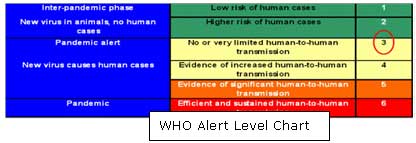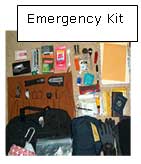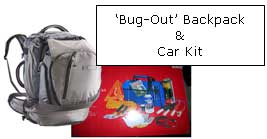Why This Is Important
Families with college students living away from home will need to plan to bring their students swiftly home, since colleges will lack the means to feed students, provide care, and prevent high infection rates in crowded dorms.
We need to be realistic and flexible. Once a pandemic begins, it may be more difficult to travel for many reasons, and we don't know how much warning we will have. So preparation for different contingencies makes sense.
Planning
Planning is the most important action you can take right now. Key parts of your plan are as follows:
- Communication. This establishes how family members will contact each other. Include back-up communication systems, and contact information for primary and alternate destination locations.
- Locations. In most cases, the primary location to reach will be home. For some, this may be the ultimate goal, with stops in betw
 een. Identify these intermediate and/or backup locations now. Make the necessary contacts and arrangement with relatives/friends. Add the contact information to the communications section.
een. Identify these intermediate and/or backup locations now. Make the necessary contacts and arrangement with relatives/friends. Add the contact information to the communications section.
- Travel. Identify primary and alternate ways to get to pre-established locations. Include detailed maps and secondary routes. Highlight the routes on an atlas, and put in your child's vehicle, along with contact phone numbers.
Once you have followed the steps above and have the plan ready, you will want to establish how and when you will take those steps

. This is called
Activation. In this part of your plan, you identify the thresholds or trigger points that drive the next steps you take. Each person has their own internal “risk meter.” For some, a threshold may be a World Health Department (WHO) declaration of ‘Pandemic level 5’. For others, the same action threshold may have been reached a week earlier by careful attention to news events. What’s important is to identify your thresholds NOW, rather than in the middle of crisis.
Flexibility: Tailor Your Plan to Your Child and School

In a severe pandemic, schools will likely close to contain spread. Colleges, universities, and boarding schools should be developing emergency response plans for a pandemic and communicating them to parents and students. Schools will want to get students home, but they must also have plans to care for those who are ill or cannot get home. Check your child's school to see what plans they have. If they have no plans, ask them “Why not?” and show them plans that other schools have. The University of Maryland is an excellent example of how one university is communicating its
Campus Infectious Disease Management Plan with students.
Many college students live “on the edge” and don't have extra cash to get home; especially if anything happens to their credit cards. In a pandemic, credit card machines might not work. Extra cash and supplies will give greater flexibility. The farther away your child is at school, the more back-up options you might need to arrange.
Preparation
 1. Dorm Room Emergency Kit.
1. Dorm Room Emergency Kit. Dorm preparation can be simple (three-day supply of food and water as for any emergency; first aid kit, etc.), or it may be more complex (two weeks or more of food and water) depending on how difficult it might be for your child to get home. Include extra cash, but be careful of theft concerns. Include personal protection against infection: nitrile or latex gloves, hand sanitizer, safety glasses, and at least a week's worth of respirators. (See: Staying Healthy-Respirators) Given the close quarters on campus, the more expensive P-100 respirators may be the better choice. Be sure your child knows how to use all these items correctly.
2. Communication. Besides a cell phone and recharger, students may need a way to text message. An emergency radio is also a good idea. Remain in communication with your child's college to learn of its plans. If you have close friends or family nearby your child's school, make sure these people have a way to communicate with you and your child.
3. Travel: 
- Car: You may arrange to pick your child up, or students may have a car on campus. Make sure ALL cars have a large road atlas with multiple routes mapped in case one route is not possible. Include a basic car emergency kit (whistle, jumper cables, money for gas, extra container for gas, etc.). Include some extra food and drinks so you and your child can minimize contact with others at rest stops along the way.
- Planes, Trains and Buses: Even a student who has a car may end up needing to get home a second way. You may wish to buy your child an open ticket on a plane, train or bus. Though expensive, a “first class, open-ended” ticket that can be used any time might make sense: in an emergency, flyers on “budget” tickets may get bumped by more “special” flyers. Planes, buses and trains all would carry more risk of exposure than car. Be sure your child has plenty of respirators and hand sanitizer to lessen risk of infection.

- Walking and Biking: If your student is healthy and physically fit, he or she could simply walk or bike to the airport, train or bus station, or even home - especially if it isn’t too far and the route is safe. Store a backpack with necessary gear: good walking shoes, maps including primary and secondary routes, extra food and water and handheld GPS unit. For personal safety, travel in groups.
4. A Safe Haven If travel cannot be arranged, what will your student do? Can they stay in their college dorm rooms until a ride arrives to bring them home safely? Could a friend, loved one, or family member who lives closer by let the student stay while school is closed or alternative arrangements can be made? This may be an extended stay; you would need to plan for this. Consider your options now.
 5. Education:
5. Education: If possible and practical, students may wish to continue their education (by computer, textbooks, etc.) in the event college is closed. There may be distance learning options offered.